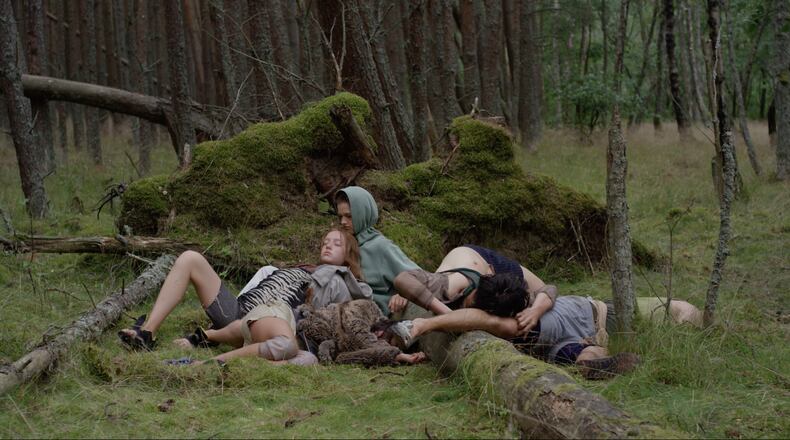This story was originally published by ArtsATL.
Nature is the artist’s oldest and, in some ways, most enduring inspiration. Perhaps that’s because nature is never impatient. Natural forces and processes move at their own pace, allowing artists to relate to it in their own time.
”Songs from the Compost: Mutating Bodies, Imploding Stars,” a meditative new film by Lithuanian artist Eglė Budvytytė, moves and shifts slowly, asking viewers to consider their relationship to time and listen deeply. Shot in the gorgeous pine forests and sand dunes of the Curonian Spit, a national park on the border between Lithuania and Russia, the film — which is on view at the Michael C. Carlos Museum through May 19 — unfolds like a nature documentary, but here humans are the subjects of observation and curiosity. (The artist will give a talk at 7:30 p.m. Thursday, Feb. 22, in the museum’s Ackerman Hall.)
Five young local performers dressed in tattered, dirty streetwear laze on a bed of moss and fallen trees, pick through each other’s hair and trudge through shallow water on their knees. Budvytytė seems to suggest that distinguishing between the behaviors of animals, plants, bacteria and fungi is neither important nor possible.
Credit: Photo courtesy of the Carlos Museum
Credit: Photo courtesy of the Carlos Museum
Throughout the film, a hypnotic, high-pitched and highly synthesized voice repeats melodic mantras like “I am a portal. I am a borderland between spirit and animal,” and “I am a shadow. I am a ghost. I’m being hosted.” Many other lyrics are barely decipherable, but the song’s ominous tone adds texture and emotional weight to scenes depicting what could be mistaken for mundane existence. Futuristic and ethereal, the song feels anachronistic to Budvytytė's ancient imagery, but somehow they work in tandem as if the voice is the Earth’s speaking to all who have and will inhabit her.
In one scene near the beginning, a person dressed in torn gray pants lies with their back to the camera, their hair splayed over the ground amid patches of lichen clinging to gray rocks. Mushrooms grow from their back, a surprising and stunning image that Budvytytė allows the viewer ample time to consider. As the seconds tick by, the half human, half fungi creature becomes simply one host for the survival of organic matter. Nothing could be more natural.
Variations of human locomotion is a recurring theme, and one that feels particularly resonant. In a striking moment, Amsterdam-based Mami Kang, who choreographed and performed the film’s solos, lurches across the sand toward the ocean, dragging her feet. Later, three other performers slide down a sand dune on their backs, press into a back bend and walk, then run on all fours like crabs seeking shelter. Water and sand create resistance to forward motion, a fact all humans have likely encountered, and yet here these moments become epic journeys.
Budvytytė took inspiration from science fiction writer and mother of Afro-futurism Octavia Butler, specifically the author’s use of concepts such as mutation and hybridity to challenge gender binaries and species categorizations.
The film’s minimalist, pedestrian movement vocabulary highlights costume elements that support these themes. A waxy material functions as a sort of second skin and, in some cases, a prosthetic or body enhancement. The substance wraps one performer’s knees, a natural protection for bare legs in the wild. It hugs the chest like a binder, calling to mind gender affirmation for trans men. It extends the fingers and, in one of the film’s most visceral moments, forms an umbilical cord that snakes from between the legs of an ambiguously gendered person sitting in repose on a concrete surface. The cord attaches to a fetus-like shape, delicately encased in the same waxy substance, and Budvytytė later reveals the location: an airport runway, the only human-made location in the film.
Credit: Photo courtesy of the Carlos Museum
Credit: Photo courtesy of the Carlos Museum
The reference to travel and commerce, the forest floor paved over to make room for progress, jolts the viewer into the present. Yet it also suggests a futuristic landscape full of abandoned structures, where humans have repurposed the concrete expanse as a suitable, warm place to take naps, sing together and give birth.
A quote by Italian writer and activist Carlo Levi comes to mind when sitting with “Songs from the Compost”: “The future has an ancient heart.” The film’s sense of ephemerality intermingles with timelessness, as if humanity — gender, body, community — will eventually forsake the concrete and return to the Earth.
Viewing “Songs from the Compost” requires a sort of delicious brain-rewiring, and Budvytytė and her collaborators offer many compelling reasons to let go and dive into their world. Slow and introspective, the film gently asks us to confront the interconnectedness of all beings and to consider what we would be doing if nature was all we had.
DANCE FILM REVIEW
“Songs from the Compost: Mutating Bodies, Imploding Stars”
Through May 19 at the Michael C. Carlos Museum, 571 South Kilgo Circle, Atlanta. 10 a.m.-5 p.m. Tuesdays-Saturdays, noon-5 p.m. Sundays. $8 adults, $6 seniors and ages 6-17. 404-727-4282, carlos.emory.edu
Filmmaker Eglė Budvytytė will give a talk at 7:30 p.m. Thursday, Feb. 22, in the museum’s Ackerman Hall.
::
Kathleen Wessel is a movement artist, choreographer, educator and writer who has been covering dance for ArtsATL since 2012. She is on the faculty in the Department of Dance Performance & Choreography at Spelman College.
Credit: ArtsATL
Credit: ArtsATL
MEET OUR PARTNER
ArtsATL (www.artsatl.org), is a nonprofit organization that plays a critical role in educating and informing audiences about metro Atlanta’s arts and culture. Founded in 2009, ArtsATL’s goal is to help build a sustainable arts community contributing to the economic and cultural health of the city.If you have any questions about this partnership or others, please contact Senior Manager of Partnerships Nicole Williams at nicole.williams@ajc.com.
About the Author
Keep Reading
The Latest
Featured





